Bridging the Gap in People Analytics Education
Introduction
The rapid growth of people analytics has created a robust demand for education in this domain. Despite the proliferation of courses, challenges in quality, accessibility, and alignment with practitioners' needs persist. This article synthesizes insights from our recent webinar and survey research by Amit Mohindra and Yuyan Sun, analyzing the demand for people analytics education, current challenges, and actionable strategies to address existing gaps. Findings suggest a need for tailored educational offerings, improved access to resources, and enhanced alignment with professional goals to meet the growing demand.
Understanding the Demand for People Analytics Education
The survey, conducted among 229 respondents, revealed a strong interest in people analytics education, with 66% expressing a high likelihood of enrolling in a course within the next 12 months. Respondents, on average, completed two courses over the past two years, reflecting an ongoing commitment to professional development.
However, the demand is nuanced, encompassing a diverse audience:
New Entrants: Students and professionals considering careers in people analytics seek foundational knowledge.
Practitioners: Intermediate and advanced professionals aim to deepen their expertise and address real-world challenges.
HR Business Partners (HRBPs): Focused on integrating people analytics insights into strategic decision-making, HRBPs prefer practical, accessible content tailored to their roles.
Panelist Jaya Maharajah emphasized the importance of practical applications for HRBPs, suggesting that case studies and relatable content could increase engagement and utility. Conversely, more technical practitioners expressed a desire for advanced, hands-on content to refine their analytical capabilities.













Challenges in the Current Educational Landscape
The survey exposed several gaps and challenges in existing educational offerings:
Dissatisfaction with Quality:
The Net Promoter Score (NPS) for people analytics courses was -19, with 45% of respondents indicating dissatisfaction. Michelle Deneau attributed this to the field’s growing complexity, suggesting that education providers must better align courses with practitioners’ needs.Difficulty Finding Courses:
A significant 73% of respondents found it challenging to identify suitable courses. While internet searches (e.g., Google, LinkedIn) and personal networks were common sources, the lack of a centralized database hindered accessibility. Amit Mohindra highlighted the need for a searchable repository of courses, tailored to specific learner profiles.Lack of Practical Application:
Intermediate and advanced practitioners noted a gap in courses offering real-world, hands-on experience. Many professionals expressed a desire for data sets and case studies that reflect the messy, unstructured nature of real-world HR data. Yuyan Sun emphasized the importance of such resources for building portfolios and showcasing skills to potential employers.
Click here to join SPA!
<-->
Click here to join SPA! <-->
Addressing the Gaps: Recommendations for the Future
The insights from the survey and webinar underscored several strategies to enhance people analytics education:
Customizing Educational Offerings:
Panelists advocated for segmentation in course design to cater to diverse audiences. For example:Foundational Courses: Geared toward students and newcomers, focusing on basic concepts and tools.
Advanced Programs: Targeting experienced practitioners, offering in-depth technical training and real-world applications.
Centralizing Resources:
Amit Mohindra is working to develop a searchable database of people analytics courses aims to address the accessibility challenge. This resource will be available to SPA Members. By consolidating course descriptions, instructor profiles, and participant feedback, this resource could guide learners in making informed decisions.Enhancing Practical Engagement:
Incorporating interactive elements such as capstones, simulations, and real-world projects can improve satisfaction and outcomes. Michelle Deneau stressed the value of combining technical rigor with business applicability to meet the needs of both data scientists and HR professionals.Expanding Accreditation and Certification:
Certifications and badges emerged as critical signals in the labor market, validating learners’ expertise. Enhancing the availability and visibility of such credentials could incentivize participation and investment in people analytics education.
Call to Action
This research and webinar provided valuable insights into the evolving landscape of people analytics education, and we want to continue to help. Rather you are an educator, practitioner, and learner, let us know if you are aware of any people analytics courses as we work to build a database. By identifying and evaluating available courses, we can collectively shape the future of people analytics education.

